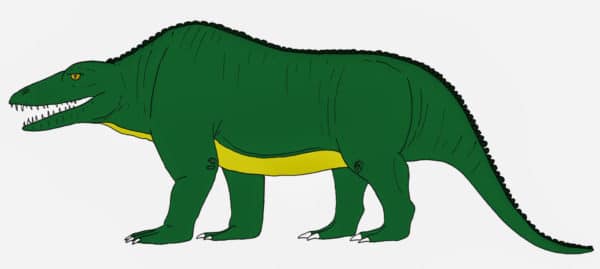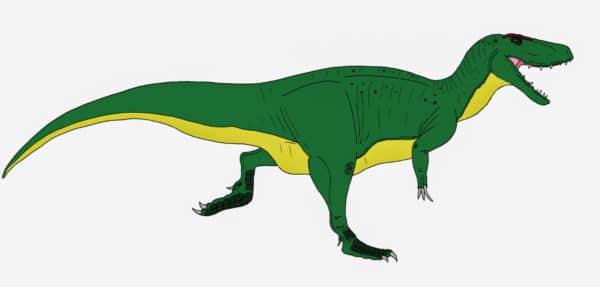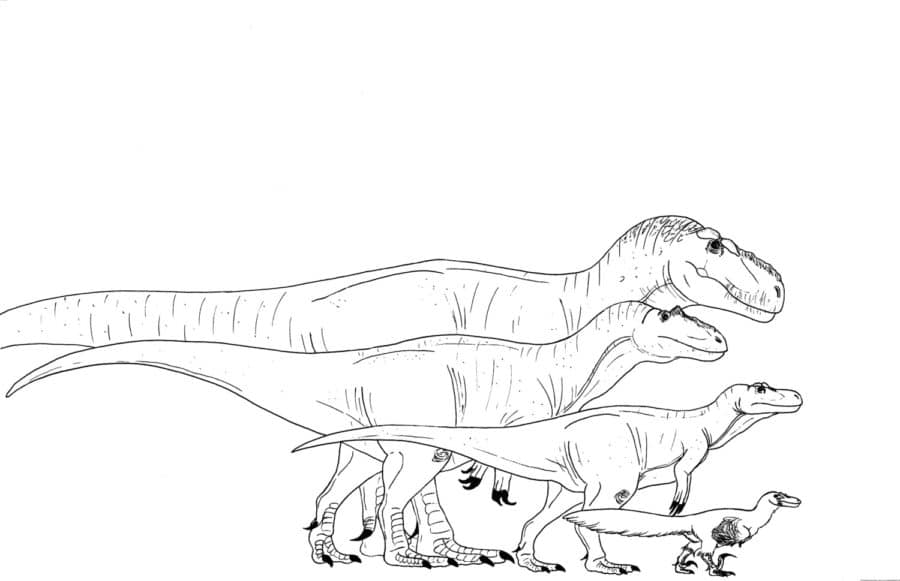
All over the world, as long as different people have been looking down at the ground and recognizing shapes in the rock, we were probably seeing dinosaur bones. Whether certain ancient cultures had some idea that they were looking at the remains of long-dead animals, and whether these remains influenced the creation of mythological creatures, remains conjectural. The thing that’s important to remember, however, is there was once a time when no one really knew what dinosaurs were. While different cultures from around the world certainly encountered dinosaur bones, it took us a while to really understand them. Ironically, the first non-avian dinosaur ever described by Western science is nearly as mysterious today as it was hundreds of years ago. Many people don’t know about this still-obscure species, and its story is long and immensely complicated. Let’s take a quick look at it here, and see what we can learn. This is the story of Megalosaurus.
Megalosaurus means ‘great lizard’, and I think it’s somewhat fitting that the first dinosaur recognized by science was named this. Remains of this animal have not always been seen as that of a big, birdlike, prehistoric archosaur, however. The first specimen that seems to be from this dinosaur was described by Oxford professor Robert Plot way back in the 1670’s. The ancient bone he had was the distal (lower) end of an animal’s femur, and Plot recognized it as such, illustrating it in his work (Plot, 1677). However, this was before a time when ideas like extinction, evolution, and fossilization were known, and so this femur end was thought at the time to be from Roman war elephants or biblical giants. Plot’s illustration was reproduced nearly a century later by English physician Richard Brookes, who labelled the fossil with his own Linnaean binomial name for it- Scrotum humanum (Brookes, 1763). No doubts about what he thought the codyles of the femur resembled…
Skip ahead to the early 19th century. All sorts of vertebrate fossils were being dug up in British quarries, and several made their way to William Buckland, an eccentric theologian and paleontology enthusiast. Some of the fossils he acquired include a partial lower jaw of some kind of prehistoric reptile with great sharp, serrated teeth, plus a handful of post-cranial bones. Along with his anatomist pals Georges Cuvier and William Conybeare (an early marine reptile expert and describer of several specimens of behalf of Mary Anning thanks for Victorian misogyny), Buckland studied these remains to figure out what exactly they were and, in 1824, described the fossils under the name Megalosaurus (Buckland, 1824).
It was unclear at the time what exactly Megalosaurus was. Being the first-ever non-avian dinosaur to receive a name, and with the science of paleontology in its infancy, Buckland and other anatomists didn’t have much to go on. The fossils of Megalosaurus were clearly from a big predatory reptile that existed long ago, but the post-cranial bones probably hadn’t come from the same individual as the jaw fragment. In his description, Buckland presented Megalosaurus as literally a giant lizard, 40 feet long and seven feet high. Over the decades, this dinosaur and many others went through a variety of depictions as paleontologists learned more and more about dinosaur biology.

What scientists of the mid-19th century thought Megalosaurus looked like. It might seem laughable by our standards today, but these early paleontologists did the best they could with very little fossil material. By Nicholas Carter
Perhaps the most iconic of old-timey Megalosaurus reconstructions are the ones seen at Crystal Palace Park in London. Created by artist Benjamin Waterhouse Hawkins under the scientific advice of anatomist Richard Owen, these sculptures of prehistoric life have stood since the 1850’s as a demonstration of what paleontology knew about fossil animals at the time. The fossil reptiles of Crystal Palace Park are a far cry from what we now believe these animals look like, but by the standards of the mid-19th century, the accuracy of Hawkins’ work was extremely rigorous. The Crystal Palace dinosaurs are held in high esteem by modern paleontologists for being the most thorough attempt in their day to reconstruct extinct organisms from poor fossil material and a knowledge of modern animal biology. All known non-avian dinosaurs at the time were large, sturdy animals with upright postures. Owen envisioned them as almost mammal-like but still with reptilian features, and this was reflected in the Crystal Palace dinosaurs. As a result of this, Megalosaurus reconstructions from this period look something like a gigantic, quadrupedal cross between a crocodile and a bear. While Owen was certainly on the right track in picturing dinosaurs as more than just giant lizards, he may have been better off looking more towards modern birds for inspiration. Once paleontologists started looking elsewhere in the world for dinosaurs, especially in western North America, the general shape and build of dinosaurs gradually became more and more understood. It’s always fun to look at how depictions of dinosaur form have evolved over the decades with updated evidence.
It didn’t take long for all sorts of unrelated theropods to be lumped, at least for a time, under the Megalosaurus name. Dinosaurs such as Dilophosaurus, Ceratosaurus, Metriacanthosaurus, Proceratosaurus, and Carcharodontosaurus were all initially classified as species of Megalosaurus. Paleontology’s first Mesozoic theropod became a waste-basket taxon – a name that scientists would lump unrelated species under for lack of anything better to call them. While some misnomers got corrected early, other theropod odds and ends got labelled as Megalosaurus until it became unclear exactly what, if anything, Megalosaurus was. Was the first dinosaur ever named just a chimera of mid-Jurassic British theropod scraps with bits of other things thrown in?
One problem was that there had never been a single definitive specimen, or holotype, selected to define Megalosaurus as a taxon. Buckland’s 1824 description had included a jaw bone, vertebrae, pelvic bones, and limbs bones which had all been assumed to come from the same species. Could paleontologists be sure that Buckland’s assumption was correct? Even if it was, did any of these bones have distinguishing features that made the animal unique and not just some jumble of ambiguous theropod material?
Opinions on this ranged back and forth, with some arguing that the original Megalosaurus material represented a chimera of undefinable animals (Allain & Chure, 2002). It was eventually decided that, at the very least, the type specimen of Megalosaurus should be the famous lower jaw fragment, making this fossil something called a lectotype- a single specimen chosen to represent a name initially described with multiple specimens. A 2008 study concluded that this jaw fragment was actually unique, and that even if the rest of the fossils didn’t come from the same animal, the diagnosable features of the jaw bone meant that Megalosaurus was a valid species after all. Later, Roger Benson went further and concluded that a variety of cranial and post-cranial bones from the same quarry that the jaw bone had been found in all belonged to Megalosaurus as well, adding a fair bit of definable material to this dinosaur (Benson, 2010).

A hypothetical reconstruction of Megalosaurus based on what we now know if its biology and anatomy. Lots inferred from the closely related Torvosaurus. By Nicholas Carter
Thanks to the fragmentary nature of what we know to be Megalosaurus, we don’t know a lot about this dinosaur’s biology. The lectotype animal is estimated to have been around 7 meters long, with larger specimens thought to reach almost 9 meters (Benson, 2010). While this certainly doesn’t put the medium-sized Megalosaurus in the ranks as one of the largest theropods, for the mid-Jurassic it wasn’t a slouch either. What we know of the megalosaur family largely comes from more complete related taxa such as Afrovenator and Torvosaurus. Megalosaurs were all generally mid-sized, square-headed predators closely related to the spinosaurs. Since they’ve been found all over the world, from Western Europe to North America to Africa, megalosaurs likely arose during the time when Pangea was mostly still together. There appears to be a trend in this family for species to get bigger over time, though they seem to have gone extinct around the Jurassic-Cretaceous boundary. The radiation of big predators like spinosaurs, ceratosaurs, and allosauriods that happened around this time might have been too much for the megalosaurs to compete with. Even big species like Torvosaurus (a dinosaur certainly deserving of more attention) that coexisted with Ceratosaurus and Allosaurus in the western United States was comparatively rare, despite being larger than these other carnivores.

R to L: Velociraptor, Megalosaurus, Allosaurus, Tyrannosaurus. A variety of carnivorous dinosaur ‘villains’ that have been featured in popular media for over 100 years. By Nicholas Carter
The history of Megalosaurus is forever tied with our own history. Before our movies, books, and museums were stalked by villains like Spinosaurus, Tyrannosaurus, Allosaurus, and the recent trend of genetically-engineered imaginary monsters, Megalosaurus was the definitive predatory dinosaur. Dickens referenced it in his work, as did Arthur Conan Doyle. Illustrations of its bones predate the Salem witch trials. Figures of it stand in Victorian gardens. And it was instrumental in the establishment of the Dinosauria as a clade of animals. While Megalosaurus was neither the first or the last dinosaur to live on Earth, wasn’t the biggest species nor known from the most complete skeleton, it caught people’s attention first. The image of the giant terrestrial predator of a far-gone past began here. Megalosaurus has always been a symbol of that lost primordial world that exists now only in our imaginations, and in the fossils that capture them.
References
ALLAIN, R. and CHURE, D. J. 2002. Poekilopleuron bucklandii, the theropod dinosaur from the Middle Jurassic (Bathonian) of Normandy. Palaeontology, 45, 1107–1121.
Benson, R.B.J.; Barrett, P.M.; Powell, H.P. & Norman, D.B. (2008). “The taxonomic status of Megalosaurus bucklandii (Dinosauria, Theropoda) from the Middle Jurassic of Oxfordshire, UK”. Palaeontology. 51 (2): 419–424.
Benson, R. B. J. (2010). “A description of Megalosaurus bucklandii (Dinosauria: Theropoda) from the Bathonian of the UK and the relationships of Middle Jurassic theropods”. Zoological Journal of the Linnean Society. 158 (4): 882–935.
Brookes, R. (1763). “A New and Accurate System of Natural History: The Natural History of Waters, Earths, Stones, Fossils, and Minerals with their Virtues, Properties and Medicinal Uses, to which is added, the Method in which Linnaeus has treated these subjects”. J. Newberry. 5: 364
Buckland, W. (1824). “Notice on the Megalosaurus or great Fossil Lizard of Stonesfield”. Transactions of the Geological Society of London. 2. 1 (2): 390–396
Plot, R. (1677). “The Natural History of Oxford-shire, Being an Essay Toward the Natural History of England”. Mr. S. Miller’s: 142.

